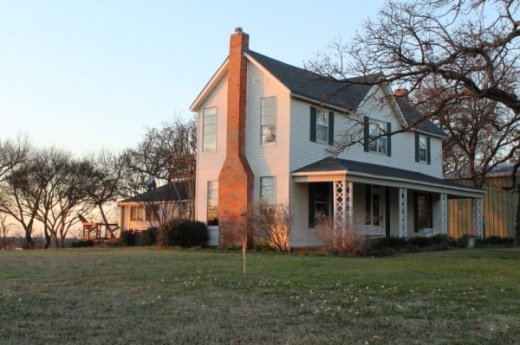The two-story house, built in 1905, currently overlooks Grapevine Lake. Grapevine Mayor Bill Tate said his city will pay to transport the house to a city-owned lot, where it will be preserved.
“The house is a piece of history of this region,” Tate said. “The property [the house] sits on was traditionally considered part of Grapevine until it was annexed in 1987. So the house has strong historical ties with Grapevine.”
David Stewart, a developer of Lakeside Village, said Tate’s willingness to bring the house to Grapevine allows history to be preserved while also making way for a new development that will allow the public to enjoy the lakeside property. David’s father, Peter P. Stewart, bought the house and the 14-acre property it sits on in 1985.

Public amenities, including parks, an amphitheater, lakeside trails and more, will be installed just feet from where the house currently stands. Developers said it will take several years for the project to reach full build-out, but construction of the public amenities is slated to begin by April.
Tate also has personal ties to the house. As a teenager, Tate spent a lot of time there visiting his friend Scott Tarwater, who grew up in the home.
“It was an absolutely idyllic childhood, being raised there,” Tarwater said.
Tarwater said he and Tate spent many a summer day fishing, quail hunting and enjoying the sunset from the back porch.
“Not only is Bill Tate a very dear friend, but he is the consummate historian and visionary for the preservation of historic things relating to the area,” Tarwater said.
Tarwater said Peter P. Stewart was a family friend before he bought the property. Peter spent many afternoons talking about his vision for what the property could be while sitting on the front porch of the home along with Tarwater; his mother, Lura Lee Tarwater; and the family’s pet parrot, Ollie.
“The most important thing to my mother at the time was that if that incredible family heirloom property was going to be placed in someone’s hands—that it would be placed in [the hands of] someone who would cherish it and keep it close to their heart and develop in a proper manner that would make our relatives very proud of it,” Tarwater said. “And now that it will be preserved, that is coming to fruition.”

Grapevine’s Historic Preservation Officer David Klempin said the city has been accepting bids from structural transportation companies to move the home. Grapevine City Council will likely vote to award a contract to one of those transportation companies at its March 3 meeting.
H.D. Snow, who has owned H.D. Snow and Son House Moving for more than 65 years, specializes in moving homes of an array of sizes, shapes and weights in Texas.
Snow said he typically tries to move homes in one piece when possible, but sometimes, when homes are not compatible with the size of local roadways, he has to move them in pieces.
Before he moves a house, Snow said he does detailed measurements of the structure itself and then maps out the route he will take to move it. If he determines that a house needs to be moved in pieces, Snow and his team will use a special saw and cut through part of the house.
“The best way to do it is just like cutting a piece of cake,” Snow said. “Sometimes there’s obstacles because you don’t want to cut through a piece of cabinetry or something like that, so that also dictates where we do the cutting,” Snow said.
His crew will then detach the house from its foundation and slide pieces of plastic under the house with bars of ivory soap, which helps the house to easily slide up onto the steel beams it will sit on during transportation, he said. When a house gets to its final location, the crew attaches the pieces back together using bolts, he said.
David Stewart said he expects the farmhouse will likely need to be moved in two pieces.
“That will be quite something— to see the house driving over the dam,” he said. “We’re just thankful that everything came together and worked out so that we could preserve this farmhouse that has so much meaning locally.”







